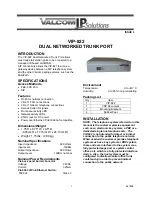
28-24
Catalyst 4500 Series Switch, Cisco IOS Software Configuration Guide - Cisco IOS XE 3.9.xE and IOS 15.2(5)Ex
Chapter 28 Configuring IGMP Snooping and Filtering, and MVR
Configuring MVR
–
Router ports or ports that are connected to another MVR switch are configured as source ports.
•
Compatible mode
A source port configuration is required for those ports that must receive MVR traffic, even when
there is no JOIN request from that port. All the MVR traffic received on the mVLAN on any port is
forwarded to all source and receiver ports. (The receiver port should have been joined either by
IGMP report or through static configurations).
•
Dynamic mode
Source port configuration is not required, unless there is a port connected to another Layer 2 switch
that runs MVR on the same mVLAN as this switch. Configure such ports as
source
ports. All MVR
traffic received on the mVLAN on any ports is forwarded to the receiver or source ports that are
joined either by IGMP report or through static configurations.
•
Only one MVR VLAN can be configured.
•
Although receiver ports that are connected to subscribers can be on different VLANs, they should
not belong to the mVLAN.
•
mRouter ports should not be configured as receiver ports.
•
Both trunk and access ports can be configured as either source or receiver ports.
•
The maximum number of MVR groups is fixed at 1500.
•
MVR cannot coexist with a PVLAN; do not configure MVR on a PVLAN.
•
The IGMPSN group MAC address can alias with an MVR group's MAC address.
For example, 225.1.1.1 and 226.1.1.1 are IP addresses whose MAC addresses match to the same
multicast MAC address (0100.5e01.0101). If 225.1.1.1 is configured as an MVR group then
225.1.1.1 is handled by MVR and 226.1.1.1 is handled by IGMPSN.
If the 226.1.1.1 host is present on the MVR trunk receiver, IGMPSN might not handle the
forwarding for 226.1.1.1. Instead, the switch treats 226.1.1.1 as an MVR group and MVR handles
forwarding on the mVLAN. You should not connect the hosts
interested
in MVR aliased groups on
the MVR trunk receiver port. (By
interested
we mean that a host sends a JOIN request for a multicast
group in order to receive the traffic or stream for that group.) This limitation applies only to MVR
trunk receiver ports.
•
MVR and multicast-routing cannot co-exist on the same switch. If you try to enable MVR while
multicast routing or a multicast routing protocol are enabled, your operation is cancelled and you
receive an error message. If you enable multicast routing or a multicast routing protocol while MVR
is enabled, MVR is disabled and you receive a warning message.
•
MVR can coexist with IGMP snooping on a switch.
•
MVR is not supported with IPv6 multicast groups.
•
MVR supports only IGMPv2 messages; MVR group reports derived from other versions are
dropped.
Configuring MVR Global Parameters
If you select the default settings, you do not need to set the optional MVR parameters. If you want to
change the default parameters (except for the MVR VLAN), you must first enable MVR.
Summary of Contents for Catalyst 4500 Series
Page 2: ......
Page 4: ......
Page 2086: ...Index IN 46 Software Configuration Guide Release IOS XE 3 9 0E and IOS 15 2 5 E ...
















































